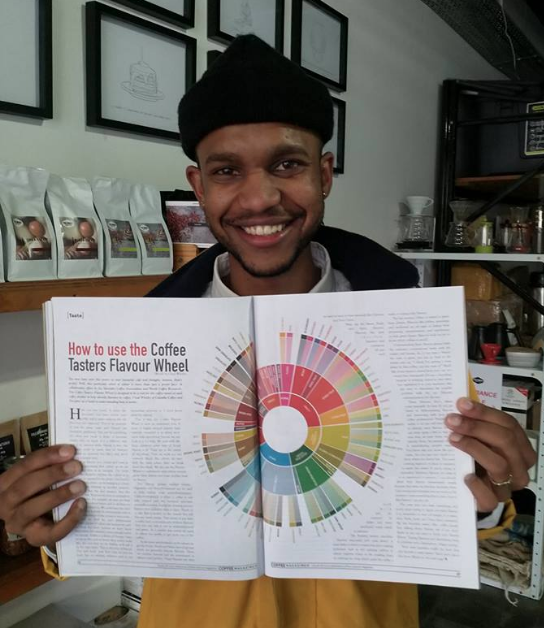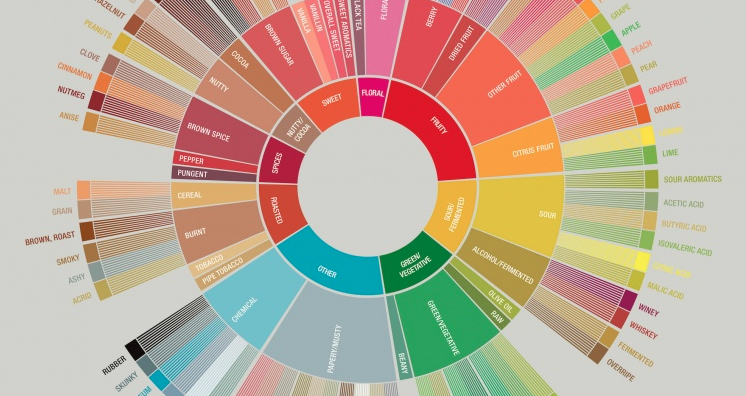You may have seen this poster in your favourite cafe and thought, hmmm, that’s pretty! Well, this particular whirl of colour is more than just a pretty face. A collaborative effort by the Specialty Coffee Association and World Coffee Research, The Coffee Tasters Flavour Wheel is designed to be a tool for the coffee taster or avid coffee drinker to help identify flavours in coffee. Chad Whitby of Colombo Coffee gives us a hand in understanding how it works.

Words by Chad Whitby
Have you ever heard, 'It tastes like chocolate”, but then receive your coffee and it tastes nothing like the chocolate you expected? This is an example of how the terms ‘taste’ and ‘flavour’ are incorrectly attributed. This can be confusing, but when you break it down it becomes simple. Let’s try think of it a different way; taste is an opinion while flavour is fact. An argument could be made that all flavours are based on opinions, but like I said, we’re keeping it simple here.
Think of flavour as a colour and taste as our brain processing that colour as we see it. Let’s use blue as an example. Our brain makes the decision whether the colour is in fact blue, as opposed to say, green. Our brain’s perception of colour can be wrong (e.g. colour blindness) or different to another person’s perception, but the fact remains that the colour is blue. Reasons for error in perception are numerous. For example, we may not have ever seen the colour before and so we have no reference of what it is. We could have also seen the colour in a poorly lit environment and so our interpretation of the colour is inaccurate.
Often we find we can't differentiate between shades of colour not because we can't see them but more because we don't know their name. For example, many mistake amber for orange. Amber is a shade of Orange. Once we know this and we know what amber looks like, the next time we see Amber, we'll call it by the right name. This is also true of flavour. Our taste buds taste Earl Grey tea but our brain has no existing reference and so our immediate response is, 'I don't know what I'm tasting'.
This is why the Coffee Flavour Wheel is such an important tool. A team of highly trained experts have carefully compiled it so when we're stuck with identifying flavour, we can look to it for help. We start with the basic question: what type of broad flavour is it? These are at the centre of the wheel. Then we work our way outward. Much like colour, we start with the basic colour then we break down the shade. We also use the Flavour Wheel to understand what effects various green bean defects and roast profiles have on flavour.

Download your own copy at SCA store.
The flavour groups marked Green/Vegetative and Sour/Fermented can be used to help explain roast underdevelopment. Underdevelopment is when a coffee is not fully roasted and the chemical processes normally activated during the roasting process haven’t had sufficient time to react. Think of a cake that is brown on the outside but still has wet batter inside. This means if you taste a coffee and come across any of these flavours that you can rule it out as underdeveloped and green. As a roaster, this means we need to adjust our profile to get more out of the coffee.
As we move anticlockwise on the wheel, we get the Fruity, Floral and Sweet flavour groups which are generally delicate flavours. These are positive flavours and are accentuated in lighter roast profiles. These flavours are what we want to taste in brew methods like Chemex and Pour Overs.
Next, are the Sweet, Nutty and Spice flavours. Flavours like dark chocolate, hazelnut and cinnamon all pair well with milk and are eminent in darker and more developed roasts suited to espresso.
The Roasted section describes flavours associated with roast defect. A roast defect is when a roaster has poor roasting technique such as not opening airflow to extract negative fumes in the roasting drum or roasting too long which gives the coffee a malty or tobacco-like flavour.
The last section, Other, is related to green bean defects. Flavours like rubber, petroleum and medicinal are all signs of defects from processing, transportation, pest interference or stale green beans. Signs to look out for to know which coffees to avoid!
Understanding these flavour groups helps the customer communicate better with the roaster and barista. So, if you taste a flavour like malt or grain, you can go back to the barista and say “I think I’m getting a roast defect in this coffee, can you taste it?” Much like if you heard a sound from your car, you would first distinguish if it was a knocking, banging or scraping sound so that when you explained it to your mechanic they can start to determine the possible problem with the car. Effective communication for the win!
These flavours don’t always come naturally. So how do you get better at differentiating flavours and interacting with your local coffee professional? Practise! The reality is no one will ever be able to identify every flavour, but we can learn quite a few so that the next time we taste them, we can identify them. An example of this is remembering people's names. You know that you know the guy’s name, but you just can't recall it or from where you know him. You need a strong memory of place or situation to spark the name! If you're trying to remember blueberry flavour, try relate it to an experience or memory. I can identify dried fruit flavour immediately simply because they were my absolute favourite when I was young and marzipan was my worst so the moment I taste something that is even close to that flavour I am put off.
The next time you taste something and you're stuck trying to figure out what flavour it is, remember to start off simple: Is it sweet, sour, fruity, nutty etc? Once that’s answered, the rest becomes easier. Also, coffee people love talking about flavour, ask if you don't know so you can start to build your flavour library. Tasting flavours and identifying them is a journey not a destination. Happy tasting!